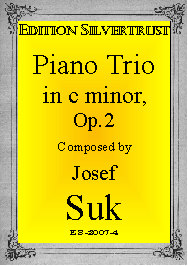Presents
Josef Suk
Piano Trio in c minor, Op.2
 Josef Suk
(1874-1935) was born in Krecovice in southern Bohemia, then part of
Austria. He studied piano, violin and organ with his father who served as
village choirmaster. His exceptional talent led to his being enrolled at the
Prague Conservatory in 1885 at the age of 11 where
he first studied violin. Eventually, he became a composition student of Antonin Dvorak. He graduated in 1891, and
kept up a friendship with Dvorak, whose daughter he married in 1898.
Josef Suk
(1874-1935) was born in Krecovice in southern Bohemia, then part of
Austria. He studied piano, violin and organ with his father who served as
village choirmaster. His exceptional talent led to his being enrolled at the
Prague Conservatory in 1885 at the age of 11 where
he first studied violin. Eventually, he became a composition student of Antonin Dvorak. He graduated in 1891, and
kept up a friendship with Dvorak, whose daughter he married in 1898.
He formed what became the world famous Bohemian Quartet with three of his fellow students. Suk played second violin with the Quartet for most of his life. From 1922, he taught at the Prague Conservatory. Among his many students were the composer Bohuslav Martinu and the pianist Rudolf Firkusny. Suk served as the Conservatory's director after 1924, on and off, until the end of his life.
The Op. 2 Piano Trio was composed while Suk was studying at the Prague Conservatory. He completed the first draft in February of 1889. It was the result of chamber music evenings at which Suk played piano trios with friends. It gave him the impetus to try his hand at writing one himself. During the course of the following two years, the trio was to undergo many changes. Originally, it had four movements, rather than the three it took it in its final form. The third movement was a short scherzo. The metamorphosis began when Suk showed the trio to his composition teacher Karel Stecker, who immediately recognized that, even in its rough form, the trio was a fine work. After Suk made the changes Strecker had suggested, the trio was publicly performed for the first time in January of 1891 at a concert at the Conservatory. As a result of this performance, Suk was recommended for a place in Dvorak’s composition master class.
Suk eventually showed the trio to Dvorak who made further recommendations, including the removal of the short scherzo. Thus by the end of 1891, the Op.2 achieved its final form. The main theme to the opening Allegro is expressed by a powerful series of piano chords against a striving melody in the strings. The slower, second theme, introduced by the cello, is more lyrical. The second movement is a striking, Andante. It is a relaxed and elegant folk dance. The lovely second subject is extremely romantic. The main theme to the finale, Vivace, is a highly original and heavily syncopated dance. Its forward energy has a bright and brilliant second part, while the second theme is an optimistic march.
We are pleased to recommend this fresh and original sounding work to both professionals and amateurs, who will surely find it pleasant to play, be it in concert or at home
Parts: $29.95